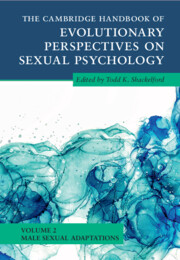Book contents
- The Cambridge Handbook of Evolutionary Perspectives on Sexual Psychology
- The Cambridge Handbook of Evolutionary Perspectives on Sexual Psychology
- Copyright page
- Contents
- Contributors
- Preface
- Part I Precopulatory Adaptations
- 1 Men’s Sexual Preferences
- 2 Men’s Extra-Pair Sexual Interest
- 3 Male Sexual Attraction Tactics
- 4 Men’s Intrasexual Competition
- 5 Competitiveness and Fatherhood as Overarching Domains of Female Choice in Human Evolution
- 6 Sexual Coercion and Rape
- 7 Mate Poaching by Men
- Part II Copulatory Adaptations
- Part III Postcopulatory Adaptations
- Index
- References
7 - Mate Poaching by Men
from Part I - Precopulatory Adaptations
Published online by Cambridge University Press: 30 June 2022
- The Cambridge Handbook of Evolutionary Perspectives on Sexual Psychology
- The Cambridge Handbook of Evolutionary Perspectives on Sexual Psychology
- Copyright page
- Contents
- Contributors
- Preface
- Part I Precopulatory Adaptations
- 1 Men’s Sexual Preferences
- 2 Men’s Extra-Pair Sexual Interest
- 3 Male Sexual Attraction Tactics
- 4 Men’s Intrasexual Competition
- 5 Competitiveness and Fatherhood as Overarching Domains of Female Choice in Human Evolution
- 6 Sexual Coercion and Rape
- 7 Mate Poaching by Men
- Part II Copulatory Adaptations
- Part III Postcopulatory Adaptations
- Index
- References
Summary
Mate poaching is engaging in premeditated behaviors to attract either short-term or long-term mates by luring them away from their already established relationship. It is unique as compared to other ways to initiate a relationship because it involves specific behaviours and consequences, given that the target is already mated. Despite the potential for negative outcomes related to the discovery of the poacher’s attempt, including homicide and intimate partner violence, it is a common occurrence. Depending on the context, cultural group, and sex, rates vary from slightly under 30 percent to over 60 percent for how many people report having attempted mate poaching. During the past two decades, there has been a noteworthy growth in our understanding of mate poaching, and this chapter will present a comprehensive review of those developments. We focus specifically on men’s use of mate poaching, with the goal of explaining how it has led to advantages over evolutionary time. There are many reasons to examine men separately from women. For example, data reveal that men, more than women, report attempting to poach short-term mates, and that they have succumbed to poaching attempts in short-term contexts. These differences imply that men receive different benefits from poaching, and being poached, than women. We start with an overview to show how frequently it occurs and some of the general traits of those who poach. Then, we use a functional approach to investigate the problems that mate poaching solves for men, as well as the associated costs. This approach allows us to document which strategies are the most effective for poaching, as well as the identity of potential targets. We conclude with suggestions for future research, including the need to be inclusive in studying mate poaching so as to more fully encompass a variety of sexual orientations, and how mate poaching leads to direct reproductive success via increased numbers of children.
- Type
- Chapter
- Information
- Publisher: Cambridge University PressPrint publication year: 2022
References
- 2
- Cited by



